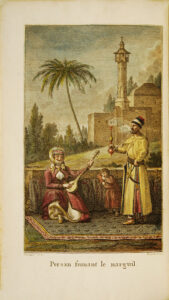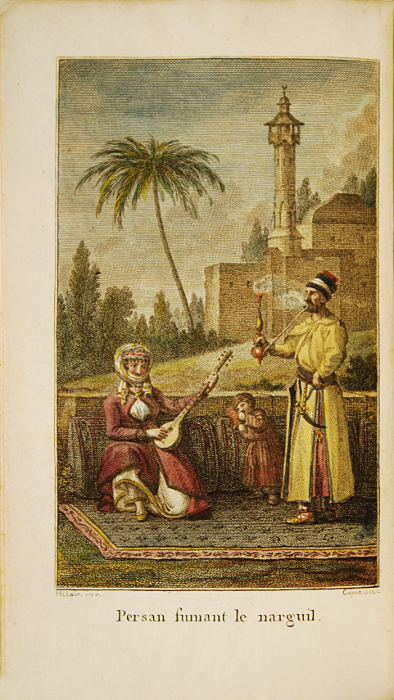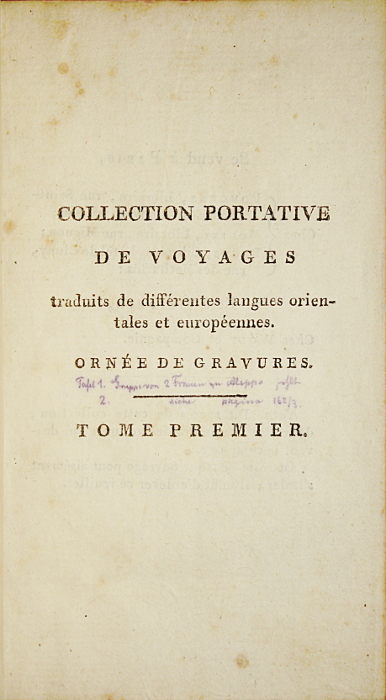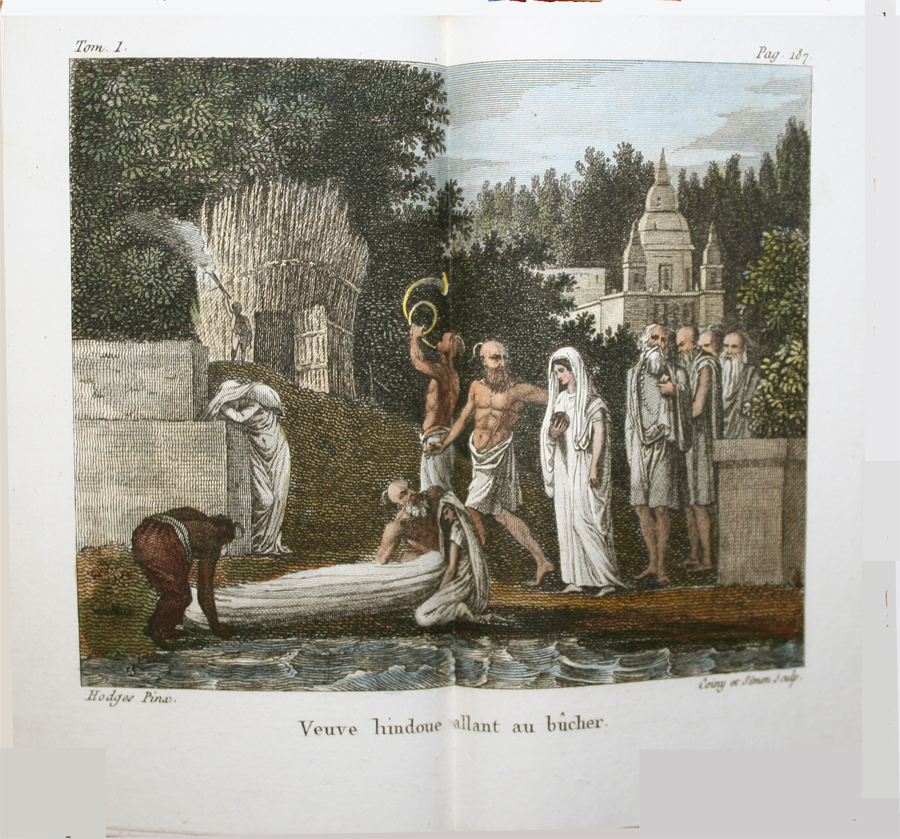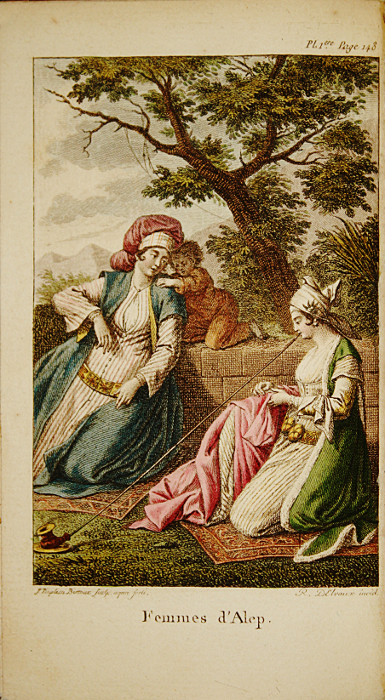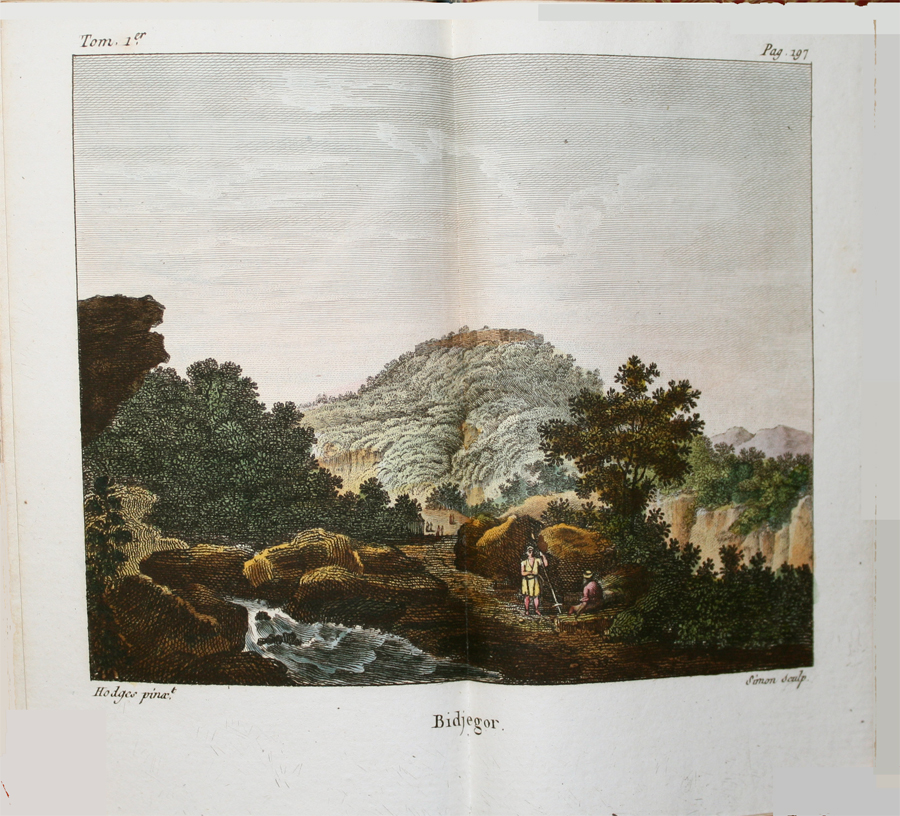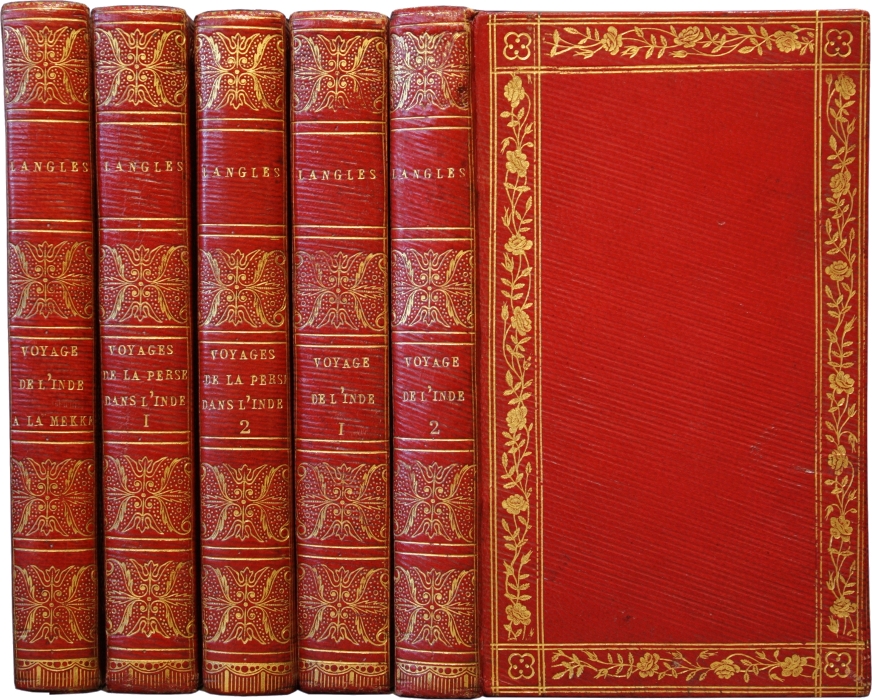Paris, Imprimeries de Crapelet et Delance, 1797-1805.
Collection of 3 works in 5 volumes 18mo:
–Voyage de l’Inde à la Mekke, par Abdoul-Kerym … extrait et traduit de la version anglaise de ses Mémoires par L. Langlès. Paris, Crapelet, 1797. 18mo of xxxii pp., 246, 2 plates.
-Voyages de la Perse dans l’Inde, et du Bengal en Perse, le premier traduit du persan, le second de l’anglais ; Avec une Notice sur les Révolutions de la Perse, un Mémoire historique sur Persépolis, et des notes ; par L. Langlès. Paris, Crapelet, 1798. 2 volumes 18mo of: I/ cxxxi pp., 142, 3 plates including 2 on double-page; II/ (2) ll., 268 pp., (3) ll., 1 plate.
–Voyage pittoresque de l’Inde, fait dans les années 1780-1783 ; par M. William Hodges, traduit de l’anglais et augmenté de notes géographiques, historiques et politiques ; par L. Langlès. Paris, Delance, 1805. 2 volumes 18mo of: I/ (2) ll., xxvii pp., 222, 10 plates on double page ; II/ (2) ll., 252 pp., 4 plates on double-page.
A total of 5 volumes 18mo [132 x 76 mm] uniformly bound in full red straight-grained morocco, gilt borders decorated with floral pattern on covers, flat spines finely decorated, gilt inner border, gilt edges. Contemporary binding.
Rare first French editions of these three accounts of travel to Asia and the Middle-East. Brunet, III, 820; Cohen, Guide de l’amateur, 597.
« Abdoul-Kerym is a Muslim pilgrim who made, with Tamas Couly-Khân, a travel from India. This travel forms the first volume of the ‘Collection portative des voyages’, translated from oriental languages and from various European languages. We count 5 volumes of this precious collection. » (Biographie nouvelle des contemporains, 447)
« The ‘Voyage de l’Inde à la Mekke’, coming with the precious and instructive notes by Langlès, is useful to acquire in a pleasant and convenient way some knowledge of India, very necessary knowledge today for any educated European; it ends with a good table of contents, and counts two beautiful engravings carefully reduced after the drawings of Rosset, which are preserved at the print room of the National library. This artist lived for a long time in the East, and his drawings are of a great accuracy; they show costumes.
The second and third volumes of this collection contain first a ‘Voyage de la Perse dans l’Inde’. This Voyage is extracted from a Persian manuscript of the National library. The author was an imam. Despite the bigotry of this Muslim, we feel that the accounts made at this time by locals of the country, always offer some details that the European literary men can usefully enjoy. Langlès ended this account with extensive and numerous notes, useful for those who study oriental languages. After that there is the ‘Voyage du Bengale à Chiraz en 1787 et 1788, traduit de l’anglais de William Francklin’. This officer from the English company settled in Bengal made an eight-months stay in Chiraz, and he presented new and interesting things about this country. After his Voyage, Mr. William Francklin gives very important notes on Persia. Mr. Francklin gave in his Voyage a description of Persepolis, that is nothing more than a repetition of what Niebuhr said. Langlès thought he should remove it; but he replaced it with very interesting memoirs, partly extracted from the various Arabic, Turkish, and Persian manuscripts of the National library. These two volumes of the collection contain four beautiful engravings, two of costumes after Rosset’s drawings, and two folding which offer a view of Chiraz and of the tomb of the Persian poet Hhâfiz. The printing is careful, and honours the presses of Crapelet. » (A. L. Millin, Magasin encyclopédique, pp. 22-26)
Therefore the French Orientalist Louis-Mathieu Langlès (1763-1824) translated and commented these three works initially published in English and Persian.
« He decided that one day he would be a member of the Indian army and therefore to devote himself to the study of eastern nations which history and customs had vividly excited his curiosity since his first youth. As his dreams took a long time coming true, he gave up the military career to devote himself exclusively to Oriental letters. With that in mind, he took courses of Arabic and Persian at the Collège de France and was introduced to Silvestre de Sacy, who guided him in his studies […]. The most beautiful title of Langlès to posterity is that he led the government of the French republic to create in 1795 the School of Oriental living languages, which still exists today. He was the first appointed administrator and teacher of Persian language. […] Langlès can be considered as one of the scholars who contributed the most to spread in France the taste for oriental languages and literatures; and we also mainly owe him the impulse that was given to those studies in the first years of the century. […] We can say of Langlès that he undeniably did Oriental studies services with the eagerness that he used to spread them and especially with the generous protection he granted to anybody who wanted to devote himself to this laborious career. » (Nouvelle Biographie générale, 29, 422)
The superb illustration is composed of 20 engravings entirely contemporary coloured, including 16 on double-page, realized by Hilair and Duplessi-Bertaux.
They represent: les Femmes d’Alep, les Arabes du désert connus sous le nom de Bédouins, Femmes d’Ispahan et de Bassorah, Vue de Chyraz, le Tombeau de Hhâfiz, un Persan fumant le narguil, la Pagode de Tandjaour, Calcutta, Zénânâ, Défilé de Sicrygolly, Arbre des Banians, Femmes musulmanes, Paysans de l’Inde, Colonne, Veuve hindoue allant au bûcher, Bidjegor, Palais de Luknau, Agrah, Mollâ et femme musulmane, Gualyor.
A very beautiful copy which engravings were entirely contemporary coloured, uniformly bound in contemporary red straight-grained morocco with the spines very finely decorated.
See less information
